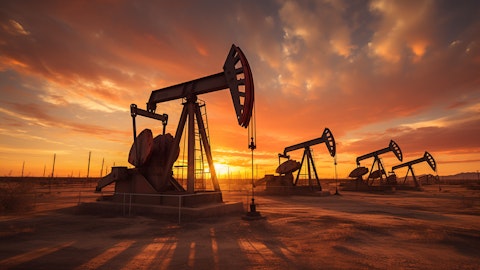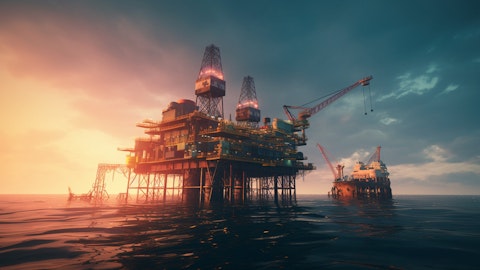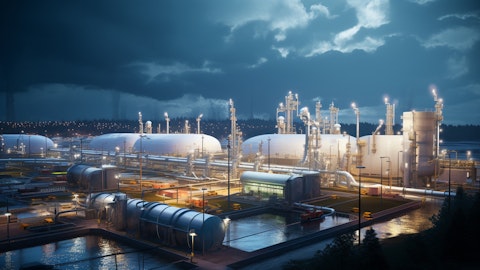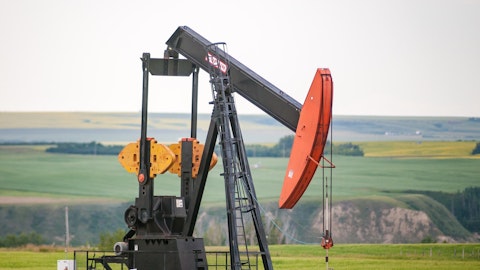And I think that makes life a little tougher to be confident about when and if things might happen. But I think the most important thing from a Kosmos perspective is actually, as we’ve commented earlier, very rich hopper set. We’ve actually got a very rich set of opportunities in the base between Equatorial Guinea, Gulf of Mexico and actually Ghana in Jubilee. We actually — the reserve replacement ratio of 104% this year was driven by the performance of Jubilee more than offsetting the downside in TEN. So there is a strong opportunity set there in Jubilee. Jubilee is a field — a big field that’s going to get bigger. And therefore, I can see us prioritizing capital there. So TEN is sort of waiting, and I’m fine with that. I think for us, it’s about ensuring that we’re putting our base capital to our best opportunities.
And certainly, Jubilee would run very highly.
Operator: Our next questions come from the line of Bob Brackett with Bernstein Research.
Robert Brackett : Returning back to the GTA FPSO and the issue around repair of fair leads. Has that FPSO been turned over from the contractor to the operator? Is there some sort of recourse in the same way as say Tortue issues, Jubilee or even the pipeline vessel issues? Will you go back to that contractor and say you didn’t deliver the FPSO on time and on scope?
Andrew Inglis: The detailed answer to your question is it has not been turned over. So I think which ultimately answers your subsequent questions.
Robert Brackett: And an easy follow-up, contrast the challenges around GTA with sort of the process of getting Winterfell up and online in the Gulf of Mexico and talk to your relative conviction there?
Andrew Inglis: You just walk us clearly in the different scale and you’re doing something which is sort of establishing a first phase of a larger project with GTA. It is a greenfield project. It’s got both got wells. It’s got an upturn or it’s got an LNG facility and it’s got an FPSO. So yes, multiple, as it were segments of the project. Winterfell much more simple sort of tieback. It’s in a basin that has the supply base and therefore access to equipment easier and its well subsidy tie back to an existing facility. So, just an ultimate different order of magnitude. And I think it’s a great question because it sort of brings you back to the fundamentals of the company. We’re investing in short cycle, fast payback ILX type opportunities on the oil side that deliver a very different economic outcome and actually risk profile.
But you create the longevity for the business in terms of building out a gas business. Now, we’re having established Tortue Phase 1 and Phase 2 is a brownfield, it comes with a very different execution risk. So, it’s hard to get started and I think we clearly struggled with Tortue to get it there. But with the end in sight, the next phase is Tortue has got a very different risk profile. So relative competence in which we’ll study up, yes, it will be at the beginning of the quarter, flow back both of the wells, it will be accompanying that with the third well to follow. And actually the interesting thing about Winterfell is not just that first phase of development, its subsequent phases. I think it will be ultimately be a much larger resource pool.
So it’s got not only a short cycle front end to it, but it has that development opportunity to follow-up.
Operator: Our next questions come from the line of Subash Chandra with Benchmark Company.
Subash Chandra : Can you reiterate — I might have missed it, Tortue volumes, what if any are included in the ’24 guide?
Andrew Inglis: Neal, do you want to cover that?
Neal Shah: Yes. And so yes, we’ve got a — basically, we’re assuming it’s in line with the detailed guidance that was in the presentation, which is there’s some entitlement volumes in 3Q and then close to the full rate in the 4Q, which works out to call it, 2,000 to 3,000 barrels a day of BOEs net with the forecast. So there’s not in the full year average. But again, it gets close to full rate within the fourth quarter.
Subash Chandra : I was just curious, so should we — is that OpEx included in the guide? I was just confused on the footnote versus the guide for the year?
Neal Shah: Yes. So the OpEx, so it’s not included in the per barrel metric. So the per barrel is basically on the base business with the OpEx just for the [MS] portion.
Andrew Inglis: The reason we’ve done that is because in the — as you go from the project to the operation, there’s quite a large commissioning element to that. So that the absolute number includes that transition, the sort of the — some of the commissioning costs and then the operating costs associated with the field as it comes online.
Subash Chandra : And finally, I guess, just apples-to-apples for CapEx last year versus the ’24 guide, how much cap interest is included?
Neal Shah: It’s about $25 million a quarter, Subash. So we’d sort of — if we look at the guidance, sort of we’re only assuming it happens in the first half of this year and then goes away in the second half of the year. So interest, hence the $25 million to sort of versus the full year $150 million guide.
Subash Chandra: And so last year, was that $100 million of cap interest?
Neal Shah: Exactly. It’s about the same, yes, annualized.
Operator: Our next questions come from the line of Matt Cooper with Peel Hunt.
Matt Cooper : So just firstly, I wonder if you could comment on the current Jubilee production rate and other two wells brought online in 1Q performing per expectations.
Andrew Inglis: Yes, Matt, sort of step back on Jubilee, I think the key points to note are performance in the year will be dependent on two issues. The first is maintenance of the base, which is about voidage replacement. We struggled to do that, really in the third quarter of last year, but really from about sort of November time onwards, we’ve been injecting water at record levels, and they’ve been at 100% voidage replacement, probably in the prior three months of that, it was as low as 40% when the water injection was down. So I feel good about the way that the base has been performing as we enter the year and actually have sort of been through the first two months. Then you’re sort of adding additional well stock. We’ve added one water injector and one producer.
I think literally, probably today, we’re adding the — second producer will start up. So once that second producer is online, we’ll be up at around sort of the 100,000 barrel a day back up above 100,000 — we’re around 100,000. So that’s an important milestone for us. Then you’ve got two more wells to follow. So you’ve got an additional producer and an additional injector. So as we look to the year and the performance in the year, I think the wells have delivered. We’re actually — when you look at the overall program, the operators would probably deliver the wells six months ahead of time, which is why we’re going to take the break and slightly earlier than we’d anticipated to allow us to rebuild that well still. But the fundamental thing to sort of we’re focusing on is the water injection and therefore the voidage replacement that sustains the pace.
Matt Cooper : And just to confirm. So those first two wells, I think you said they went in early 1Q. The injection and the production that you’re seeing from those is in line with expectations at the moment?
Andrew Inglis: Yes, it’s in line with expectations. And you can — yes, they’re in line with expectations. The base is probably a little bit better than we saw but fundamentally in line with expectations. So then with the second well, second produce starting up now. The objective was to be above that 100,000 barrels a day and that’s what we anticipate to be. So yes, it’s — the start of the year has been solid, yes. And the key thing, and I keep bashing on about it, but getting the base properly supported is the key thing that we need to focus on.
Matt Cooper : Just finally, I just wanted to ask on EG. I wondered how much strip in the infill drilling out reduced 2024 production? Just kind of thinking about how much upside there could be there if you do procure a rig this year? And then kind of the flip side, about how much risk is there that the new rig will be at a higher cost?
Andrew Inglis: Yes. So basically, Neal will come back to the production numbers. Yes, the other contract was probably done at a more advantageous time in the market. So yes, I think we’ll probably see a slightly higher rig rate. But again, with all — I know it tends to be a headline number you look at but you’ve got to remember that it’s a relative, probably 1/3 of the cost of the overall spread rate. So even small, an increment there gets diluted on that basis. And then you’ve got to figure out how you deliver low NPT. So ultimately, the well costs — the absolute well costs then go up. So yes, we will see a slightly higher rig cost but it’s not something that is ultimately going to interfere with the capital guidance or with the economics of the wells.
Neal Shah: then just on the production, yes, the guide we have for EG is around 8,000 barrels a day net for the year, if we sort of drill as planned, we were closer to sort of 11,000. So it’s about a 3 million barrel a day impact we can get. Again, I think some of that — there is some upside if we do end up drilling this year, but that’s not included in the base guidance.
Operator: Our next questions come from the line of Mark Wilson with Jefferies.
Mark Wilson : Very clear on the catalyst for this year and the CapEx once you get through Tortue. First of all, just given an idea of the physical work within that $550 million a year and the maintenance split, are you expecting to be — that we would have for instance an ILX well in the Gulf of Mexico from each year from 2025, given the success you’ve seen with Winterfell and Tiberius as one part of that CapEx? And also, are you assuming a return of a rig to Jubilee in 2025 and onwards? That’s the first question.
Andrew Inglis: So if you sort of conceptualize it yes, if you look at the base and the maintenance of the base, we’re looking at three quarters of a rig year in Jubilee. Now clearly, as it were that being sort of rollover. So yes, the rig would return in ’25, would maybe drilling ’26, and then a break and so on, yes. If you sort of figure it out that there’s probably three quarters of a rig year that makes sense, whereas actually this year, we’ll have sort of half of a rig year in Ghana. So yes, it does include that. It includes a similar sort of drilling program in Equatorial Guinea going forward, sort of, yes.
Neal Shah: Yes, but once every 18 months.
Andrew Inglis: About once every 18 months and maybe a package of sort of three wells. Those are the primary base pieces. Then in the Gulf of Mexico, yes, probably at a sort of 30% working interest sort of one ILX well per year. We sort of run the $20 million or $30 million. That would be in the growth pre sell.
Neal Shah: That would be in that $200 million to $250 million of growth versus the $300 million to $350 million in maintenance, which really cover the Jubilee EG and occasionally some GoM maintenance drilling.
Mark Wilson : And then over to Tortue. I just want to confirm all the physical things for the startup have been discussed. Are there any commercial arrangements to be finalized before those first LNG? And maybe tie into that what are the outcomes or any kind of impact from that? You said that the contractual discussion should — or debate should be resolved in the middle of the year? Does that — what should we look at around that?
Andrew Inglis: Yes. So cargo divisions, the timing of the arbitration is around mid-year, decision will be around midyear. The arbitration itself will be held in the second quarter. And typically, you get a ruling sort of a couple of months afterwards, so probably around mid-year. And I think in terms of — so the — ultimately, the contractual arrangements aren’t going to slow down the completion of the project, actually executing the physical work is the thing that is driving the timeline.
Mark Wilson : And there was a question on the call, someone asked about Phase 2 potentially coming back into view. Is that — is there any update worth giving on Tortue Phase 2 versus the other projects in Senegal or a longer-term timeline?
Andrew Inglis: As we’ve said in the past, Phase 1 is about building out the infrastructure. I think what I would say is there’s a real push from the NOCs to find the right next concept for Phase 2 that fully utilizes the infrastructure that’s been laid in and that is a new conversation that’s occurring now with the NOCs. So partly, on back of the work we’re doing on the Yakaar Teranga, both SMH and PETROSEN are interested in seeing how we can accelerate the timeline for Phase 2, it’s clearly in the country’s interest and actually is the interest of the partnership ahead of the day the BP had previously guided. So that’s the conversation that’s going on there, Mark.
Operator: Thank you. Since there are no further questions at this time, I want to bring the call to a close. Thanks to everyone joining today. You may disconnect your lines at this time and thank you for your participation.





